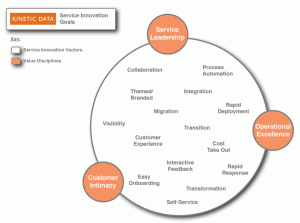What’s New at Kinetic: Building Smart in 2026
At Kinetic, we believe the future of Business Process Management isn’t bigger—it’s smarter.
Industry analysts covering service providers at Gartner and Forrester Research monitor the evolving structure of outsourcing deals on a constant basis. These analysts report an interesting trend –...

Industry analysts covering service providers at Gartner and Forrester Research monitor the evolving structure of outsourcing deals on a constant basis. These analysts report an interesting trend – innovation is included as a deliverable in an increasing number of deals.
What can a service provider do to ensure a constant stream of innovations that can be delivered to their clients?
There are three related pieces to address this that service providers using Kinetic Request bundled with Kinetic Task can adopt. The first is re-purposing service items developed for other clients, demonstrations, trade conferences, RFPs, etc. In our last service provider blog post on enterprise value, we explored the enterprise value that accrues to service providers by capturing, replicating, and re-deploying useful service items. Service items configured using Kinetic Data’s architecture contain a task tree that is a visible representation of the actual service item. It is abstracted from the branding and theming so as to be re-usable and is portable (see series of blogs on Service Item Portability) so it can run in any BMC Remedy environment version 6 or greater. Inventions designed for one purpose or client can be captured, re-branded, zipped up, installed, tested, and registered for another client. Innovation number one.
 In a related move, an existing service item can be cloned and modified, creating a new innovation. An example of this might be to add a robust approval process for service/product requests that goes down different paths based on data collected such as dollar amounts or urgency. A well planned master library will include this approval process as a task handler that can be pulled into any service item, connected, configured, tested, zipped up, installed and registered as a new service item. Innovation number two.
In a related move, an existing service item can be cloned and modified, creating a new innovation. An example of this might be to add a robust approval process for service/product requests that goes down different paths based on data collected such as dollar amounts or urgency. A well planned master library will include this approval process as a task handler that can be pulled into any service item, connected, configured, tested, zipped up, installed and registered as a new service item. Innovation number two.
Since Kinetic Data service items are made up of configuration data with no programming change to the underlying service platform source code, playing with, testing, and experimenting are encouraged and do not pose a risk. This kind of sense and respond innovation can happen reactively or proactively without the time, cost and risk of programming. Service innovators need only a business process analyst level of familiarity in order to sense and respond their way to new service items. Innovation number three.
Service innovation can come in many forms. Having a configuration driven, portable approach with an eye towards re-using service items and their component parts to modify existing service items is one easy way to achieve your service innovation goals one piece at a time.

At Kinetic, we believe the future of Business Process Management isn’t bigger—it’s smarter.

IT support automation uses software workflows, rule engines, AI/ML, and integrations to automate...

Business process reimagined is the strategic renewal of how work gets done by combining modern digital...